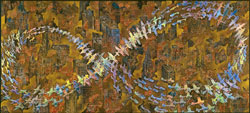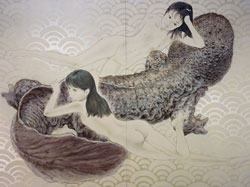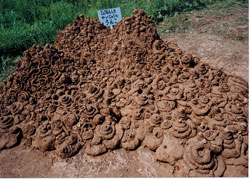Aomi Okabe: In the film Near Equal Aida Makoto, your studio was used for the set, which looked like a traditional Japanese living room. Has your studio always been like that? Makoto Aida: No, that studio was only for temporary use right after I came back from the states. I borrowed that place for about one year. Usually, I don’t own a studio of my own because I tend to end up using it as storage. Okabe: It seems that you have been producing gigantic art pieces like; A Picture of an Air Raid on New York City (War Picture Returns) and The Gaint Member Fuji versus King Gidora. Have you always liked to paint big? Aida: Yes. I have about 4 reasons why I like big paintings. First of all, I’m a natural-born idiot. I consider the stupidity as one of my talents. I’d like audiences to laugh at it when they see my work and to get that kind of effect they’ve got to be massive. I have my own theory that big pieces are meant for good laughs, and small pieces are for intellectual stuff. In addition, most of the collectors I’ve met, with the exception of Mr. Ryutaro Takahashi, are only capable of purchasing small pieces. I’d like to place my art pieces in museums rather than to furnish private living rooms. I don’t mean to say that museums are greater than private collections though. But with museums, although you need to pay the entrance, you can go there with your friends or for dates on Sundays. I think my work is more suited for such places.
Okabe: (laughter) I think your pieces are quite dramatic and shocking as well. Aida: I’d say they are dramatic and shallow. I kind of think it is okay to be shallow. It’s good enough for me if one of my art works is recognized as a symbol and leaves an impression to audiences. They are like a funhouse or ghost house at a local fair, in the way that you don’t have to gaze at them forever with adoration. They cannot satisfy someone who visits museums to stare at paintings, like Mark Rothko’s, to receive some kind of religious excitement. My work has a different purpose Student: I heard that when you were in university, you used to think you ought to paint in a Japanese style because you are Japanese. Do you think there’s a difference between Japanese and foreign perspectives on Japan’s culture? Aida: They are utterly different. I personally think there are two distinct characteristics of what is considered Japanese. One is the traditional aspect of Japan. For example, ukiyo-e is now popular all over the world. As well as Manyoshu (the oldest collection of Japanese poetry) which is almost impossible to grasp its context, especially for foreigners. The other aspect is the dark side of modern Japanese reality, which is difficult to introduce abroad. For example, you can see this in the photographs of Takashi Honma. Looking at the everyday landscapes of Japan that he portrays, you don’t see poverty but a certain hollowness, a landscape arising after the Second World War, artificially peaceful and clean, but slightly rotten… I’m not good at these kinds of expressions, but that’s fine by me. There are people who are good at it. There was a time when Tsuguharu Fujita recognized internationally, whereas in Japan he was criticized of the frivolous dumping image of the country. I think that Takashi Murakami is in a similar situation as Fujita these days. The interesting thing is that now young artists in China and Korea are trying to gain visibility by making fun of own countries. They are mocking communism and China’s 4000 year history of Occultism. I consider that this is a very positive way of taking things. They pursue with vitality, anything that could enable them to become successful in the art business. It is totally okay that Murakami chose manga as his way of gaining his publicity to survive in this global society. However, I think it is also important for us, as Japanese, to feel some degree of shame in doing so. Okabe: Looking at A Picture of as Air Raid on New York City (War Picture Returns) and Mutated Hanako made me wonder what would happen if an anti-America person actually goes to the States. How did you feel about that when you were staying in America? Aida: Being anti-America didn’t help me in getting along with people. It was largely a language problem however. It’s not that I revealed anti-American sentiment by getting involved in a massive debate or anything, though. I’m idiotically emotional so that it is almost a reflex to react against anything associated with invasion. Probably the fact that my father was left-wing might have something to do with it. I even got angry when I randomly watched some educational or cultural program on the NHK (Japan Broadcasting Corporation) channel about the 6th century of European history on aggression. It disgusts me to hear even an ancient story where a country invades into others without courtesy. Therefore, I revolt at the conquest of the American Continent and of course what happened in South America. I must admit though, I’m contradictable and a hypocrite for being a little self-defensive towards the Japanese army during the Pacific War. Okabe: A Picture of as Air Raid on New York City (War Picture Returns) can be observed as the dream the Japanese army supposedly had after the Pearl Harbor attack, right? Nothing like that happened in history, though. Aida: Yes, indeed. This is why I call myself a hypocrite. I can understand the ecstasy in invasion, too. Okabe: In contrast, Japanese war paintings back then only portrayed reality. They seem to have rejected any emotional desires or dreams. Am I right to say that you have depicted the dreams that the Japanese army supposedly had?
Aida: You are probably right. The official salon artists in that era were a lot more grown up compared to us, contemporary artists. They believed that art should portray real human beings even in an emergency like during war. I think these culturally educated people for being so mature. Okabe: What do you think about today’s Japanese museums as an artist? Most of your pieces are large-scale and it seems that you are conscious of placing them in public spaces like museums. Let us know how you think about this. Aida: I’d like Japanese museums to have courage. If the lack of money is the problem, it is exactly when they should distribute young artists. Young artists are eager to satisfy their desire for self-expression and therefore would commit exhibitions even if there is little money involved. The most important thing is, Tsuyoshi Ozawa has said it too, to start an exhibition in Japan and take it abroad to introduce Japanese culture towards the world. That is what top museums in each country must do. Therefore, the most important museum of contemporary art in the country, like Museum of Contemporary Art Tokyo, needs to take on the role broadcasting Japanese art all over the world. I strongly believe that this museum should have such an ambition. (At Mizuma Art Gallery, November 18th, 2003, translated by Mei Matsubara, revised by Emma Ota) 会田誠 (アーティスト、1965年新潟生まれ、東京で活動) 岡部あおみ:会田さんが登場なさっている映画『会田誠 〜無気力大陸〜』という映画の舞台に使われている和室のようなアトリエは昔からですか? (2003年11月18日 場所:ミヅマアートギャラリー) 
Makoto Aida © Mizuma Art Gallery
A Picture of an Air Raid on New York City (War Picture Returns) 1996
© Mizuma Art Gallery
Giant Salamander 2003
© Mizuma Art Gallery
Shinkansen Super-Express (from the series of "Minna to Issho") 2002
© Mizuma Art Gallery

Shit by Jomon-type Monster 2003
© Mizuma Art Gallery
会田誠:いや、あれはアメリカから帰国してすぐの一時しのぎで、空いてた物件に、一年ぐらい仮に居候させていただいていただけです。僕はアトリエはあまりもったためしがないんです、すぐ物置きになってしまうし。
岡部:会田さんの作品には、大型の作品が多いですよね。『紐育(にゅうようく)空爆(くうばく)の図(ず)(戦争画RETURNS)』、『巨大フジ隊員VSキングギドラ』など。昔から大きいサイズの絵を描くのお好きですか?
会田:そうですね。四つくらい理由があって、まず僕は生まれつきホントに馬鹿だし、馬鹿っぽいのが売りで、作品もあわよくば笑って欲しいときが多く、そういうときは、だいたい大きい方がいい。目安として、笑わせたいお馬鹿作品はでかく、考え込ませたいお利口な作品は小さく、っていう法則があると思うんです。あと、僕らがよく出会うコレクターだと、高橋龍太郎先生などは例外として小さいサイズの商品しか買えない。僕はコレクターの個人のお宅のリビングを飾るよりは、美術館の方が好きなんですね。美術館の方が偉いっていう意味ではなくて、美術館はだいたい有料だろうけど、何百円か千円ぐらい払って、日曜日とかデートとかで暇つぶしとかで行ってみんなで見られる。そういう場で見せる方が合ってる。
岡部:(笑)。かなり過激ですからね。インパクトあります。
会田:過激っていいますか、過激でかつ浅いでしょ。浅くていいと思ってるところもあって。一期一会。記号としてインプットされて、あういうの見ちゃったなと記憶が残ればいい。まじまじと見て愛したいと思わなくてもいいという意味で、縁日のお化け屋敷的、ビックリハウス的なんですよね。マーク・ロスコみたいに、毎日毎日見て、色々な宗教的な感動を得たい人には、物足りないどころか目障りな作品でしょうけれど、目的が違う。
学生:大学で自分は日本人らしい絵を描かなきゃいけないと思ったとおしゃっていたんですが、日本人が思う日本的なものと、海外の人が感じる日本的なものは、認識に差があるとお考えですか?
会田:ものすごくありますよね。ぼくが日本的っていったときも、細かく言えば2つの要素に分解されて、海外にとって人気のある浮世絵とか、海外の人にはついてもいけないだろうけど万葉集とか、日本の伝統文化という意味の日本的がある。またあまり海外にも紹介されにくい、恥部や暗部も含んだ現代のリアルな日本の問題もある。例えば、ホンマタカシさんの写真とか、なんとなく寂しい、でも貧しくもない日本の普通の風景。戦後の、いろいろあって出来上がった平和みたいな、ちょっと腐った、でも清潔な・・・でもあまりそっちの表現は僕はいまだに出来ないし、得意な人がいるから、いいんですけど。
藤田嗣治とかも、世界では世界の藤田って言われていたけれど、国内では軽薄な日本の叩き売りと軽蔑されてた。今まさに、村上隆さんと藤田の状況は似てますよね。でも中国とか韓国の最近出てくる現代アーティストは、すごく自分の国をネタに、西洋でビックになろうとするじゃないですか。共産主義であることとか、中国4千年のいろんなオカルトチックな歴史とか。それはポジティヴシンキングで、ビックになれるものなら、なんでも使うというバイタリティ。村上さんもそういう国際社会のバイタリティの中で勝つには、マンガならマンガを売りにして、国際レベルでは全然OKなことだと思う。それをちょっと気恥ずかしいと思う日本人の心も、大切だとは思うんですけど。
岡部:「戦争画リターンズ」や『ミュータント花子』を見ていて、会田さんは反米だと思っていたのですけど、反米の会田さんがアメリカに行って、いったいどうなるのかと。アメリカに滞在していて、ご自分ではそうした面を全然意識してなかったですか?
会田:やっぱり反米という面もあるから、友達も結果的にはできなかったし、それは英語が大きいんですけど。かといってどこかですごいディスカッションや熱いけんかをして、反米家会田を見せつけてきたわけでもない。僕は多分馬鹿で、極端なくらい感情的に、反射的に侵略ってことにムカツクタイプで、まあ、父親が左翼だったからだと思うんですけど。NHKの教育番組なんかで、6世紀ヨーロッパ史とか真面目な人間講座みたいのがあったりするでしょ。人が古代に攻め入ってとか、そんな話でもむかむかしてきて、人の国なのに勝手に土足で踏み込みやがってとか、だからやっぱり、アメリカ大陸とかの征服を考えただけで、基本的にむかついている。南米ももちろん。そのくせ日本軍の太平洋戦争の時は、ちょっと日本軍の自己弁護的な考えを抱かんでもないとか。矛盾してるところもあるでしょうね。
岡部:『紐育(にゅうようく)空爆(くうばく)の図(ず)(戦争画RETURNS)』は、真珠湾攻撃に続く日本軍の夢ですよね?全然叶わなかったけれども。
会田:そうですね、だから矛盾している。征服のエクスタシーも分かるんですから。
岡部:でも日本の戦争画は、写真のかわりになるべく、戦場のリアリズムというか、そういうものに終始していて、露骨な征服の夢や欲望は語らずに、ある意味でおとなしい。結局、会田さんは、当時の日本軍の持っていたはずの夢と欲望みたいなのものを描いているという面もありますよね。
会田:確かに。あの頃の帝展とかの画家たちは僕ら現代美術家よりよっぽど大人です。芸術って言うのは戦争のような非常時にあっても、「人間」を描くものだとか、あのころの文化人はそんなふうなところがあって、ある意味で大人。
岡部:会田さんは、アーティストとして、現在の日本の美術館の状況はいかがですか?会田さんの場合は大作が多く、美術館のような公共空間での展示を重視していらっしゃる気がします。そういう立場から今の美術館状況をどうごらんになっているのかと。
会田:もっと度胸をもって欲しいですね。お金が無いなら無いで、そういう時こそ若手を使えばいい。若手はみな発表欲を満たしたいから、そんなにお金がでなくても参加しますよね。重要なのは、これは小沢剛君なんかが言ってたことでもあるけれど、日本で展覧会を立ち上げてそれを海外に持っていって日本の紹介をするといった、こちらから発信するのが各国の現代美術のナンバー1の美術館の役割だから、それはまさに東京都現代美術館の役割だし、そのぐらいの野心がなくてはおかしいです。
↑トップへ戻る

| top | about CP |
Copyright © Aomi Okabe and all the Participants
© Musashino Art University, Department of Arts Policy and Management
ALL RIGHTS RESERVED.
©岡部あおみ & インタヴュー参加者
©武蔵野美術大学芸術文化学科
掲載情報の無断使用、転載を禁止致します。